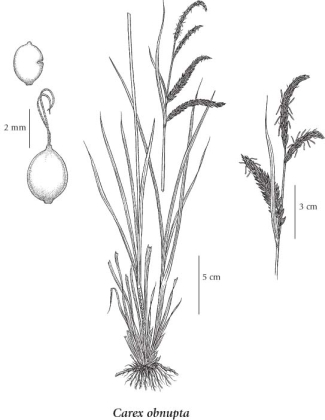Carex obnupta L.H. Bailey
slough sedge
Cyperaceae (Sedge family)
Introduction to Vascular Plants
slough sedge
Cyperaceae (Sedge family)
Introduction to Vascular Plants
Species Information
General:
Perennial, densely tufted herb from long, creeping rhizomes and fibrous roots, the roots with soft, reddish-brown hairs; stems 30-150 cm tall, arising a few or many together, longer than the leaves.
Leaves:
Sheaths tight, cross-wrinkled, reddish- to brownish-tinged at the base, the lowest ones breaking into threads; ligules as long as wide, rounded; blades 2 to 5 per stem, flat to channeled, borne on the lower 1/4 of the stem, 3-10 mm wide, the lower ones reduced.
Flowers:
Spikes 3 to 7, the terminal 2 (sometimes 1 or 3) linear, 1.5-6 cm long, long-stalked, with many male flowers, the lower spikes 2 to 4, cylindrical, 1.5-6 cm long, with female flowers, or some with male flowers above the female flowers, these short-stalked, spreading or nodding; bract subtending the lowest spike leaflike, sheathless, longer than the inflorescence, the bracts reduced above.
Fruits:
Perigynia broadly egg-shaped, leathery, 2.2-3.5 mm long, 1-1.2 mm wide, greenish or brownish, biconvex, smooth, faintly nerved, marginally 2-ribbed, the bases round, short-stalked, beakless or short-beaked, the beaks 0.1-0.2 mm long, entire or nearly so; female scales lanceolate, long-pointed or awned, as wide as and much longer than the perigynia, reddish-brown to dark brown, with 3-nerved, lighter centres, with narrow, translucent margins; stigmas 2; achenes lens-shaped, sometimes constricted in the middle, smooth, 1.6-2.2 mm long.
Illustration

If more than one illustration is available for a species (e.g., separate illustrations were provided for two subspecies) then links to the separate images will be provided below. Note that individual subspecies or varietal illustrations are not always available.
Illustration Source: The Illustrated Flora of British Columbia
USDA Species Characteristics
Flower Colour:
Yellow
Blooming Period:
Mid Spring
Fruit/Seed characteristics:
Colour: Brown
Present from Spring to Summer
Source: The USDA
Ecology
Ecological Framework for Carex obnupta
The table below shows the species-specific information calculated from
original data (BEC database) provided by the BC Ministry of Forests and Range.
(Updated August, 2013)
The table below shows the species-specific information calculated from
original data (BEC database) provided by the BC Ministry of Forests and Range.
(Updated August, 2013)
| Site Information |
Value / Class |
||
|
Avg |
Min |
Max |
|
| Elevation
(metres) |
98 | 0 | 1230 |
| Slope
Gradient (%) |
4 | 0 | 75 |
|
Aspect (degrees) |
215 | 0 | 330 |
| Soil
Moisture Regime (SMR) [0 - very xeric; 4 - mesic; 8 - hydric] |
6 | 1 | 8 |
| Modal
Nutrient Regime
Class |
D | ||
| #
of field plots species was recorded in: |
314 | ||
| Modal
BEC Zone Class |
CWH | ||
|
All BEC Zones (# of stations/zone) species was recorded in |
CDF(36), CWH(239), MH(1) | ||
|
Source:
Klinkenberg 2013
|
|||
Habitat and Range
Swamps, marshes, riverbanks, wet meadows and alluvial forests in the lowland zone; common in S coastal BC; S to CA.Status Information
Synonyms
Synonyms and Alternate Names:
Carex magnifica Dewey ex Piper